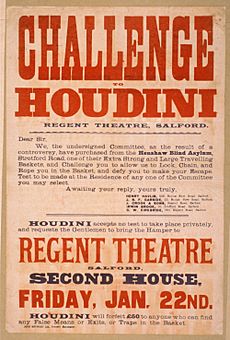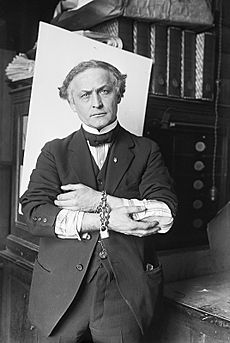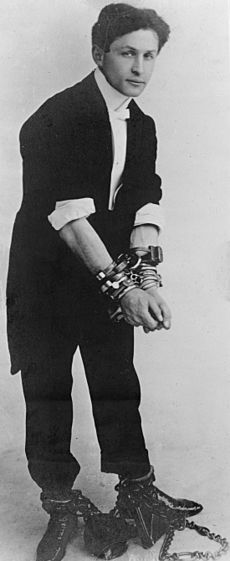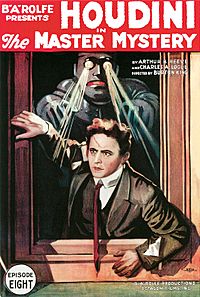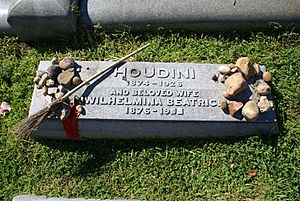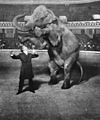Harry Houdini facts for kids
Quick facts for kids
Harry Houdini
|
|
|---|---|
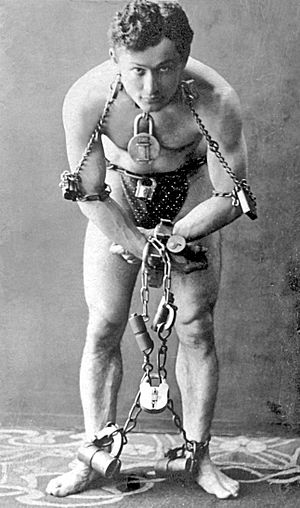
Houdini in 1899, in chains to mimic his escapist stunts
|
|
| Born |
Erich Weisz
March 24, 1874 Budapest, Kingdom of Hungary, Austria-Hungary
|
| Died | October 31, 1926 (aged 52) Detroit, Michigan, U.S.
|
| Cause of death | Peritonitis |
| Resting place | Machpelah Cemetery |
| Nationality | Hungarian |
| Occupation |
|
| Years active | 1891–1926 |
| Height | 5 ft 6 in (168 cm) |
| Spouse(s) | |
| Relatives | Theodore Hardeen (brother) |
| Signature | |
Harry Houdini (born Erich Weisz; March 24, 1874 – October 31, 1926) was a famous Hungarian-American escape artist, magician, and stunt performer. He was known for his amazing escape acts. His stage name, Houdini, was a tribute to a French magician he admired, Jean-Eugène Robert-Houdin.
Houdini first became well-known in the United States. Then, he toured Europe as "Harry 'Handcuff' Houdini." He challenged police forces to lock him up, but he always found a way out! Later, he added more daring stunts. He escaped from chains, ropes hanging from tall buildings, and even straitjackets while underwater. He also held his breath inside a sealed milk can filled with water.
In 1904, thousands of people watched him try to escape from special handcuffs in London. He kept them guessing for over an hour! Another time, he was buried alive and barely managed to dig his way out. Even though some people thought his escapes were fake, Houdini worked hard to expose fake spiritualists. He was the President of the Society of American Magicians. He wanted to make sure magic was seen as a real skill, not something supernatural. He also quickly sued anyone who copied his escape stunts.
Houdini tried making movies, but he stopped when they didn't make much money. He was also very interested in flying. He even wanted to be the first person to fly a powered aircraft in Australia.
Contents
Early Life and Family History
Erich Weisz was born in Budapest, Kingdom of Hungary. His family was Jewish. His parents were Rabbi Mayer Sámuel Weisz and Cecília Steiner. Harry was one of seven children. His half-brother was Herman. His full siblings were Nathan, Gottfried, Theodore, Leopold, and Carrie Gladys.
Erich arrived in the United States on July 3, 1878, with his mother and four brothers. The family changed their last name to Weiss. Erich became Erik. They lived in Appleton, Wisconsin, where his father was a rabbi.
In 1882, his father lost his job, and the family moved to Milwaukee. They became very poor. In 1887, Erich and his father moved to New York City. As a child, Erich worked many jobs. He first performed in public as a nine-year-old trapeze artist. He called himself "Ehrich, the Prince of the Air." He was also a champion cross country runner.
Becoming a Magician
When Erich Weiss became a professional magician, he started calling himself "Harry Houdini." He chose this name after reading the autobiography of French magician Jean-Eugène Robert-Houdin in 1890. He thought adding an "i" to a name meant "like" in French. Later, Houdini said the name "Harry" was a tribute to American magician Harry Kellar. But it was probably just a nickname for "Ehrich."
As a teenager, Houdini learned from magician Joseph Rinn.
Houdini started his magic career in 1891. At first, he didn't have much success. He performed in dime museums and sideshows. He even pretended to be "The Wild Man" at a circus. Houdini first focused on card tricks. He even called himself the "King of Cards." While he was good at card tricks, his real talent soon became clear: escape acts.
In the early 1890s, Houdini performed with his brother Theodore, who was called "Dash." They were known as "The Brothers Houdini." They performed at the Chicago World's Fair in 1893. In 1894, Houdini met a performer named Wilhelmina Beatrice "Bess" Rahner. Bess and Houdini got married. Bess then joined his act, and they became "The Houdinis." Bess was his stage assistant for his entire career.
Houdini's big break came in 1899. He met a manager named Martin Beck in Minnesota. Beck was very impressed by Houdini's handcuffs act. He told Houdini to focus on escapes. Soon, Houdini was performing in the best vaudeville theaters in the country. In 1900, Beck arranged for Houdini to tour Europe.
In London, Houdini showed his skills at Scotland Yard. He baffled the police so well that he was booked for six months at a famous theater. His show was an instant hit! He became one of the world's highest-paid entertainers. He also toured the Netherlands, Germany, France, and Russia. He became known as "The Handcuff King."
With his new wealth, Houdini bought a dress said to have been made for Queen Victoria. He held a big party and presented his mother wearing the dress to all their relatives. Houdini said it was the happiest day of his life. In 1904, Houdini returned to the U.S. and bought a house in Harlem, New York City.
In 1906, Houdini started his own magazine, the Conjurers' Monthly Magazine. He used it to share his ideas about magic and sometimes criticize others.
From 1907 and through the 1910s, Houdini had great success in the United States. He freed himself from jails, handcuffs, chains, ropes, and straitjackets. He often did this while hanging from a rope high above street audiences. Because other magicians started copying him, Houdini stopped his "handcuff act" in 1908. He began escaping from a locked, water-filled milk can. The danger of this act thrilled his audiences.
Houdini also started his "escape challenge" act. He invited people to create things to hold him. These included nailed wooden boxes (sometimes lowered into water), metal boilers, wet sheets, mail bags, and even the belly of a whale! Brewers in some cities challenged Houdini to escape from a barrel filled with beer.
Houdini wrote a book about the history of magic called The Unmasking of Robert-Houdin (1908). In this book, he said that his former idol, Robert-Houdin, had lied about inventing some tricks.
Houdini introduced the Chinese Water Torture Cell in Berlin, Germany, on September 21, 1912. He was hung upside-down in a locked glass and steel cabinet filled with water. He held his breath for more than three minutes. He performed this escape for the rest of his life.
During his career, Houdini explained some of his tricks in books for other magicians. In Handcuff Secrets (1909), he showed how many locks could be opened with force or with shoestrings. Other times, he used hidden lockpicks or keys. When tied in ropes or straitjackets, he would make his shoulders and chest bigger. This gave him a little room to wiggle free.
His straitjacket escape was first done behind curtains. But his brother, Theodore, found that audiences liked it more when they could watch him struggle. Sometimes, both brothers performed straitjacket escapes while hanging upside-down from a building!
Houdini was a top act in vaudeville for most of his career. He was the highest-paid performer in American vaudeville for many years. One of his most famous illusions was making a full-grown elephant disappear from the stage at the New York Hippodrome. In 1923, Houdini became president of Martinka & Co., America's oldest magic company.
He was also president of the Society of American Magicians (S.A.M.) from 1917 until he died in 1926. Houdini wanted to create a large group of magicians. He traveled everywhere, giving speeches and hosting dinners for magic clubs. He believed that if all magicians joined together, they would be stronger. He helped many local magic clubs join the S.A.M. By the end of 1916, he had created the biggest and longest-lasting organization of magicians in the world.
In his last years (1925-1926), Houdini had his own show. It was called "Three Shows in One: Magic, Escapes, and Fraud Mediums Exposed."
Famous Escapes
The Daily Mirror Handcuff Challenge
In 1904, the London Daily Mirror newspaper challenged Houdini. They had special handcuffs that took a locksmith five years to make. Houdini accepted the challenge for March 17 at London's Hippodrome theatre. About 4,000 people and over 100 journalists came to watch.
The escape took over an hour. Houdini came out from behind his screen several times. At one point, he asked to take off his coat. The newspaper's representative refused. Houdini then used a penknife to cut his coat off. About 56 minutes later, Houdini's wife, Bess, appeared on stage and kissed him. Many people thought she gave him the key. But the key was six inches long, so it's unlikely she could have hidden it. Houdini went back behind the curtain. After one hour and ten minutes, he came out free! The crowd cheered, and Houdini cried. He said it was one of his hardest escapes.
Some people later suggested that Houdini and the newspaper might have planned the challenge. They think his long struggle was just for show.
The Milk Can Escape
In 1908, Houdini created his own act, the Milk Can Escape. In this act, Houdini was handcuffed and sealed inside a large milk can filled with water. He made his escape behind a curtain. He even asked audience members to hold their breath with him. This act was a huge hit! Houdini soon made it even harder. He had the milk can locked inside a wooden chest.
Houdini performed the milk can escape for only four years. But it is still one of the acts most connected to him. His brother, Theodore Hardeen, continued to perform it for many years.
The Suspended Straitjacket Escape
One of Houdini's most popular stunts was the suspended straitjacket escape. He would be strapped into a straitjacket and hung upside-down from a tall building or crane. Then, he would escape in front of a huge crowd. Sometimes, tens of thousands of people would watch, stopping city traffic. Houdini often did this from the office building of a local newspaper to get more attention. In New York City, he performed it from a crane building the subway. He escaped in just two minutes and thirty-seven seconds!
There are films of Houdini doing this escape. You can see them at The Houdini Museum in Scranton, Pennsylvania.
The Overboard Box Escape
Another famous stunt was escaping from a nailed and roped wooden box after it was lowered into water. He first did this in New York's East River on July 7, 1912. Police wouldn't let him use a pier, so he hired a tugboat and invited reporters. Houdini was locked in handcuffs and leg-irons. Then, he was nailed into the box, which was tied with ropes and weighed down. The box was lowered into the water. He escaped in 57 seconds! The box was pulled up, still intact, with the handcuffs inside.
Houdini performed this escape many times. He even did a version on stage in a huge tank of water.
The Buried Alive Stunt
Houdini performed a "buried alive" stunt at least three times. The first was in California in 1915. It almost killed him. Houdini was buried in a six-foot-deep pit of earth without a coffin. He got tired and panicked while trying to dig his way out. He called for help. When his hand finally broke the surface, he passed out. His assistants had to pull him out. Houdini wrote that the escape was "very dangerous."
His second "buried alive" stunt was to show up a performer who claimed to use magic to stay in a sealed coffin for an hour. On August 5, 1926, Houdini stayed in a sealed coffin submerged in a swimming pool for one and a half hours! He said he used controlled breathing, not magic.
Houdini planned an even bigger "buried alive" stage escape for his show. He would escape after being strapped in a straitjacket, sealed in a coffin, and buried in a large tank of sand. But he died before he could perform it. The bronze coffin he made for this stunt was used to carry his body after his death.
Movies and Flying
In 1906, Houdini started showing films of his outdoor escapes during his vaudeville act. In 1909, he made a film in Paris called Marvellous Exploits of the Famous Houdini in Paris. It showed some of his famous escapes.
In 1918, Houdini starred in a 15-part movie series called The Master Mystery. This led to him signing with Famous Players-Lasky Corporation/Paramount Pictures. He made two more movies with them: The Grim Game (1919) and Terror Island (1920).
The Grim Game is thought to be his best movie. For many years, it was considered lost. But a copy was found and restored by Turner Classic Movies. It was shown to the public in 2015, 96 years after it was made!
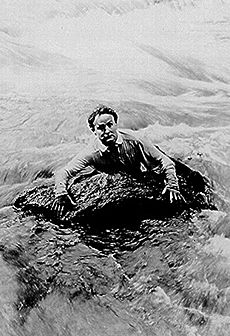
While filming a stunt for The Grim Game, two planes crashed in mid-air. A stuntman was hanging from one of the planes. The movie's publicity said it was Houdini himself, but it was a stuntman. After these movies, Houdini started his own film company, "Houdini Picture Corporation." He made and starred in two more films: The Man from Beyond (1921) and Haldane of the Secret Service (1923).
Neither his acting career nor his film company did very well. He quit the movie business in 1923, saying the profits were "too meager."
Houdini the Aviator
In 1909, Houdini became very interested in flying. He bought a French Voisin biplane. He made his first successful flight on November 26 in Hamburg, Germany.
The next year, Houdini toured Australia. He brought his biplane with him. He wanted to be the first person to fly a powered aircraft in Australia.
Australia's First Flights
On March 18, 1910, Houdini made three flights in his biplane in Australia. He flew for up to 3½ minutes and reached an altitude of 100 feet. Nine people signed a paper saying he did it.
At the time, many people thought Houdini's flights were the first in Australia. But they were actually the third. The first was by Colin Defries on December 9, 1909. The second was by Frederick Cyril Custance on March 17, 1910, just one day before Houdini's flight.
Houdini flew again on March 20 and March 21, 1910, making longer flights.
After his Australia tour, Houdini stored his plane in England. He said he would use it to fly between cities during his next tour. He even promised to jump from it while handcuffed! But he never flew again.
Appearance and Voice
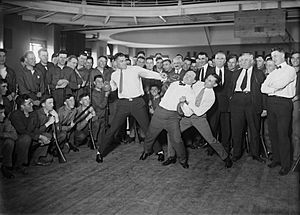
Houdini was not a tall man. He was about 5 feet 5 inches tall and had a strong build. He usually wore a long coat and tie on stage. He was said to be slightly bow-legged, which helped him get slack during his rope escapes. Reporters often described him as "happy-looking" and "good natured," with a "pleasant smile."
Houdini made the only known recordings of his voice on wax cylinders in 1914. On them, he practiced speeches for his Chinese Water Torture Cell act. He also had his sister recite a poem, and then he recited it in German. These recordings were found after magician John Mulholland died in 1970. They are now part of David Copperfield's collection.
Personal Life
Houdini was an active Freemason.
In 1904, Houdini bought a townhouse in Harlem, New York City. He paid $25,000 for the large house. He lived there with his wife, Bess, and other relatives until he died in 1926. A plaque on the building says, "The magician lived here from 1904 to 1926 collecting illusions, theatrical memorabilia, and books on psychic phenomena and magic."
In 1919, Houdini moved to Los Angeles for filming. He lived in a house owned by his friend Ralph M. Walker. The Houdini Estate, a tribute to him, is located nearby.
Houdini's Death
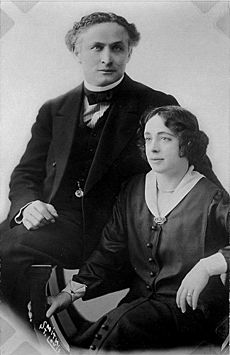
Witnesses said that Houdini's death might have been caused by Jocelyn Gordon Whitehead. This happened in Houdini's dressing room in Montreal. Whitehead reportedly punched Houdini's abdomen several times.
Students Jacques Price and Sam Smilovitz saw what happened. Price said Whitehead asked Houdini if it was true that punches to the stomach didn't hurt him. Houdini replied that his stomach could take a lot. Whitehead then delivered "hammer-like blows." Houdini was lying on a couch because he had broken his ankle a few days earlier. Price said Houdini winced and stopped Whitehead, saying he hadn't had a chance to prepare for the blows.
Houdini performed that evening in great pain. He couldn't sleep and was in pain for two days. But he didn't see a doctor. When he finally did, he had a fever of 102°F (39°C) and serious appendicitis. Doctors told him to have surgery right away. He ignored their advice and decided to do his next show. When Houdini arrived at the Garrick Theater in Detroit on October 24, 1926, for his last performance, he had a fever of 104°F (40°C). He still went on stage. He reportedly passed out during the show but was revived and finished. Afterward, he was taken to Grace Hospital in Detroit.
It's not clear if the punches caused his death. Doctors aren't sure if blunt force can cause appendicitis. Houdini's insurance company concluded that his death was due to the dressing-room incident and paid double the insurance money.
Houdini's Grave Site
Houdini's funeral was on November 4, 1926, in New York. Over 2,000 people came. He was buried in the Machpelah Cemetery in Glendale, Queens. The crest of the Society of American Magicians was carved on his grave. A statue of his head was added in 1927. In 1975, vandals destroyed the statue. New statues were placed there until 2011. Then, a group from the Houdini Museum in Scranton, Pennsylvania, placed a permanent statue with his family's permission.
The Society of American Magicians was supposed to take care of the grave. Houdini had left a lot of money to the society. But for many years, only Dorothy Dietrich and Dick Brookz from the Houdini Museum in Scranton, Pennsylvania, cared for the grave. In 2013, the Society of American Magicians voted to take financial responsibility for the grave's care.
The Society's president, Dal Sanders, said that Harry Houdini is a very important figure. He said the grave is the Society's responsibility. The current president, Kenrick "Ice" McDonald, said they want to honor the "Babe Ruth of magicians." The Houdini Museum in Pennsylvania is helping with the restoration.
Magicians Dorothy Dietrich and Dick Brookz have been taking care of the grave for years. Dietrich said, "This is a monument where people go and visit on a daily basis." She said the grave needed a lot of repairs. The Society of American Magicians and the Houdini Museum are working together to fix it.
To this day, the Society holds a broken wand ceremony at the grave every November.
Houdini's wife, Bess, died in 1943. She wanted to be buried next to her husband. But her Catholic family did not allow her to be buried in a Jewish cemetery. She was buried in Gate of Heaven Cemetery in New York.
Houdini's Legacy
Houdini's brother, Theodore Hardeen, inherited his magic props. Houdini's will said that all his props should be "burned and destroyed" after Hardeen's death. But Hardeen sold many of them to magician Sidney Hollis Radner. This included the water torture cell. Many of Houdini's props were displayed at The Houdini Magical Hall of Fame in Niagara Falls, Ontario. In 1995, a fire destroyed the museum. But many props, like the mirror handcuffs and a milk can, survived. They were later sold at auctions.
Radner loaned most of his collection to a museum in Wisconsin. But he took it back in 2003 and sold it in Las Vegas.
Houdini was a great collector of books and papers about magic and spiritualism. He left many of them to the Library of Congress. This became the basis for the Houdini collection there.
In 1934, most of Houdini's collection of theater materials and personal papers were sold to pay off debts. In 1958, this collection was given to the Hoblitzelle Theatre Library at the University of Texas at Austin. This library later became part of the Harry Ransom Center. The collection includes a very old book from 1584 about witchcraft.
In 1991, illusionist David Copperfield bought all of magician John Mulholland's Houdini collection. This is now stored in Copperfield's warehouse in Las Vegas. It has the world's largest collection of Houdini items. It includes his stage props, his rebuilt water torture cabinet, and his metamorphosis trunk. It's not open to the public, but magicians and researchers can visit by invitation.
On October 31, 1975, Houdini was given a star on the Hollywood Walk of Fame.
The Houdini Museum in Scranton, Pennsylvania, says it is "the only building in the world entirely dedicated to Houdini." It is open to the public. It shows Houdini films, gives tours about his life, and has a magic show. Magicians Dorothy Dietrich and Dick Brookz opened it in 1991.
The Magic Castle in Los Angeles, California, a club for magicians, has Houdini séances. These are performed by magician Misty Lee.
The House of Houdini is a museum in Budapest, Hungary. It says it has the largest collection of original Houdini items in Europe.
The Houdini Museum of New York is located at Fantasma Magic in Manhattan. It has hundreds of items that belonged to Harry Houdini.
Houdini's Movies
- Merveilleux Exploits du Célébre Houdini à Paris – Cinema Lux (1909) – playing himself
- The Master Mystery – Octagon Films (1918) – playing Quentin Locke
- The Grim Game – Famous Players-Lasky/Paramount Pictures (1919) – playing Harvey Handford
- Terror Island – Famous Players Lasky/Paramount (1920) – playing Harry Harper
- The Man from Beyond – Houdini Picture Corporation (1922) – playing Howard Hillary
- Haldane of the Secret Service – Houdini Picture Corporation/FBO (1923) – playing Heath Haldane
Images for kids
-
Harry Houdini before he jumped off the Harvard Bridge in Boston in 1908
-
Houdini swims above Niagara Falls in a scene from The Man from Beyond (1922)
-
Heavyweight boxer Jack Dempsey mock-punching Houdini (held back by lightweight boxer Benny Leonard)
-
Houdini and his wife Bess
See also
 In Spanish: Harry Houdini para niños
In Spanish: Harry Houdini para niños





